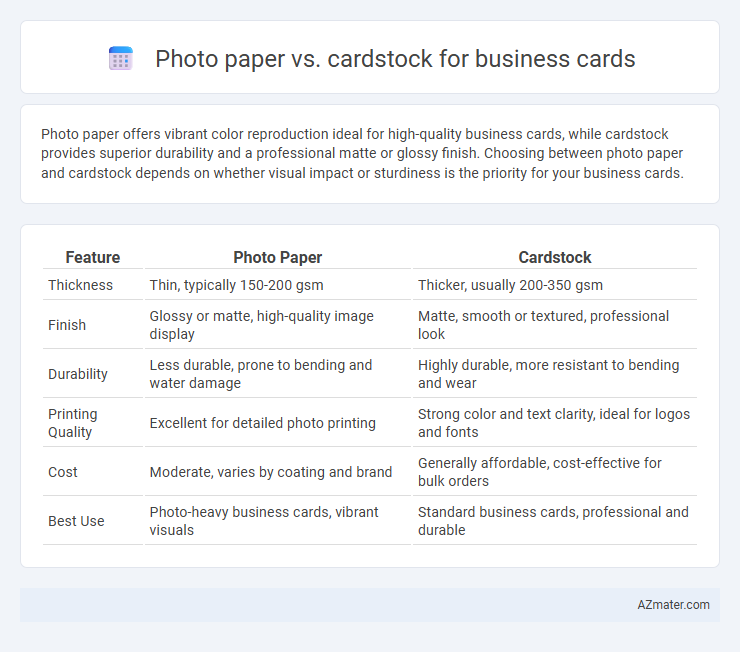Photo paper offers vibrant color reproduction ideal for high-quality business cards, while cardstock provides superior durability and a professional matte or glossy finish. Choosing between photo paper and cardstock depends on whether visual impact or sturdiness is the priority for your business cards.
Table of Comparison
| Feature | Photo Paper | Cardstock |
|---|---|---|
| Thickness | Thin, typically 150-200 gsm | Thicker, usually 200-350 gsm |
| Finish | Glossy or matte, high-quality image display | Matte, smooth or textured, professional look |
| Durability | Less durable, prone to bending and water damage | Highly durable, more resistant to bending and wear |
| Printing Quality | Excellent for detailed photo printing | Strong color and text clarity, ideal for logos and fonts |
| Cost | Moderate, varies by coating and brand | Generally affordable, cost-effective for bulk orders |
| Best Use | Photo-heavy business cards, vibrant visuals | Standard business cards, professional and durable |
Introduction: Choosing the Right Material for Business Cards
Photo paper offers vibrant color reproduction and a glossy finish, ideal for visually striking business cards that emphasize detailed images and sharp graphics. Cardstock provides superior durability and a tactile, professional feel with a matte or uncoated surface, making it a popular choice for long-lasting, high-quality business cards. Selecting between photo paper and cardstock depends on the desired balance between visual impact and sturdiness for effective brand representation.
What is Photo Paper?
Photo paper is a glossy or matte coated paper designed to produce high-quality, vibrant images with sharp details, ideal for photo printing. Unlike cardstock, photo paper typically has a thinner profile and is formulated to absorb ink evenly, resulting in vivid color reproduction and crisp visuals. This makes photo paper suitable for business cards emphasizing photographic elements or intricate designs that require enhanced color depth.
What is Cardstock?
Cardstock is a thick, durable paper that provides a sturdy and professional feel ideal for business card printing. Unlike photo paper, which is glossy and designed to enhance photographic images, cardstock offers a matte or textured finish that improves print clarity and longevity. Its high GSM (grams per square meter) rating, usually between 200 and 350, makes cardstock resistant to bending and tearing, ensuring business cards maintain their shape and professionalism over time.
Appearance and Print Quality Comparison
Photo paper offers vibrant color reproduction and sharp image details ideal for photo-centric business cards, delivering a glossy finish that enhances visual appeal. Cardstock provides a sturdier, matte or textured surface that exudes professionalism and durability, ensuring the business card withstands handling without compromising print clarity. For high-resolution logos and detailed graphics, photo paper excels, while cardstock supports premium ink absorption for crisp text and a tactile, elegant feel.
Durability and Longevity
Photo paper offers vibrant color reproduction and a glossy finish but tends to be less durable and more prone to bending and scratches compared to cardstock. Cardstock, typically thicker and sturdier with weights ranging from 80 lb to 110 lb, provides enhanced durability and longevity, making it ideal for business cards that endure frequent handling. Investing in high-quality cardstock ensures your business cards maintain their shape and professionalism over time, resisting wear and tear better than photo paper.
Texture and Feel
Photo paper offers a glossy or satin finish that enhances vibrant colors and sharp details, creating a smooth and polished texture ideal for visually striking business cards. Cardstock provides a thicker, more rigid feel with a variety of textures such as linen, smooth, or matte, lending a professional and tactile quality that conveys durability and sophistication. The choice between photo paper and cardstock hinges on the desired tactile impression and brand image, with photo paper emphasizing visual impact and cardstock emphasizing heft and texture.
Suitability for Different Printing Techniques
Photo paper excels in inkjet and dye-sublimation printing, delivering vibrant colors and sharp images ideal for business cards featuring detailed graphics or photographs. Cardstock, with its thicker and more rigid structure, is better suited for laser printing and embossing, providing durability and a premium tactile feel important for professional business cards. Selecting the appropriate material depends on the desired printing technique and the business card's intended use, balancing image quality with physical robustness.
Cost Considerations
Photo paper offers a lower-cost option for business card printing with vibrant colors and glossy finishes but generally lacks the durability of cardstock. Cardstock, while more expensive, provides a sturdier and more professional feel that can enhance brand perception and withstand wear. Evaluating the trade-off between price and quality is essential for businesses aiming to balance budget constraints with a lasting impression.
Environmental Impact
Photo paper typically has a higher environmental impact due to its glossy coatings and chemical treatments, which complicate recycling and increase waste. Cardstock, especially if made from recycled materials or certified by sustainability organizations like FSC, offers a more eco-friendly option with better recyclability and lower chemical usage. Choosing uncoated or minimally treated cardstock further reduces environmental strain while maintaining durability for business cards.
Which One is Best for Your Business Card Needs?
Photo paper offers vibrant color reproduction and a glossy finish ideal for eye-catching business cards, while cardstock provides durability and a professional tactile feel with a matte or textured surface. Choosing between photo paper and cardstock depends on your brand's aesthetic priorities and the desired longevity of your cards. For high-impact visual appeal, photo paper is best; for sturdy, classic business cards, cardstock is the optimal choice.

Infographic: Photo paper vs Cardstock for Business card
 azmater.com
azmater.com